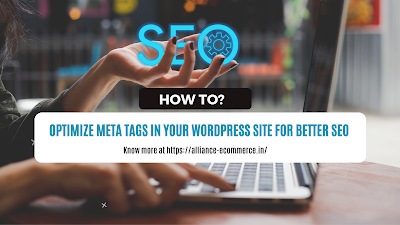How to Optimize Meta Tags in Your WordPress Site for Better SEO?
Search Engine Optimization (SEO) is an essential part of any successful website. It's the process of optimizing your website to rank higher in search engine results pages (SERPs) to increase traffic, leads, and sales. One critical aspect of SEO is meta-analysis, which involves analyzing your website's meta tags to ensure they are optimized correctly.
How do I integrate SEO with my WordPress site?
Before Conducting the SEO Meta-analysis process, you should know how to integrate SEO with your WordPress site. Integrating SEO with your WordPress site is an essential step toward improving your website's visibility and attracting more traffic.
Here are some steps you can take to integrate SEO with your WordPress site:
Install an SEO plugin: WordPress has several SEO plugins that you can use to optimize your site, including Yoast SEO, All in One SEO Pack, and RankMath. These plugins help you to optimize your site's meta descriptions, title tags, and other critical elements that search engines use to rank your site.
Optimize your content: Ensure that your content is optimized for the search engines by including relevant keywords, meta descriptions, and tags. You can use tools like Google Keyword Planner to research the best keywords to use in your content.
Use SEO-friendly URLs: Your site's URLs should be simple, descriptive, and easy to read. WordPress automatically generates URLs for your posts and pages, but you can customize them to make them more SEO-friendly.
Use responsive design: A responsive design ensures that your site is accessible on all devices, including mobile devices. Search engines prefer responsive sites and are likely to rank them higher.
Speed up your site: A fast-loading site is essential for SEO. You can speed up your site by optimizing your images, using caching plugins, and choosing a reliable hosting provider.
Use social media: Social media can help you to promote your site and attract more traffic. Integrating social media sharing buttons on your site makes it easy for users to share your content on social media. To share your posts or web pages URL on social media channels in a concise manner, you can use the custom URL Shortener tools that are easily available online. Using shortened links, you can increase your click-through rate because they become more appealing to the reader and impact their decision to engage.
Build backlinks: Backlinks are linking from other sites to your site. You can build backlinks by guest posting on other sites, participating in forums, and creating high-quality content that others will link to.
HOW TO CONDUCT THE SEO META-ANALYSIS ON YOUR WORDPRESS SITE?
In this guide, we'll show you how to conduct SEO meta-analysis on your WordPress site to improve its search engine visibility.
Step 1: Review Your Meta Tags
The first step in conducting SEO meta-analysis on your WordPress site is to review your meta tags. Your website's meta tags include the meta title, meta description, and meta keywords. To check your website's meta tags, navigate to your site's home page, right-click, and select "View page source." Look for the <head> section and search for the meta tags.
Step 2: Optimize Your Meta Tags
Once you've reviewed your website's meta tags, it's time to optimize them. To optimize your meta tags, follow these best practices:
Meta Title: The meta title is the title that appears at the top of your browser window and the SERP listing. Use your target keyword at the beginning of the title and keep it under 60 characters. Make it compelling to encourage users to click on your SERP listing.
Meta Description: The meta description is the short description that appears beneath the meta title in the SERP listing. Keep it under 160 characters and use your target keyword. Make it clear, concise, and compelling to encourage users to click on your SERP listing.
Meta Keywords: The meta keywords are a list of keywords that describe your website's content. While search engines don't use meta keywords for ranking purposes, including them can help them better understand your website's content. Use relevant keywords that describe your website's content.
Step 3: Check Your Website's Content
In addition to optimizing your website's meta tags, you should also ensure that your website's content is optimized for search engines. Your website's content should include your target keyword, and it should be high-quality, engaging, and relevant to your audience.
HOW TO ADD THE SEO META TAGS FOR A BLOG POST ON THE WORDPRESS SITE?
To add SEO meta to a specific blog post, follow these steps:
Navigate to the "All Posts" section in the blog C-panel.
Select the desired blog post where you want to add the SEO meta.
Click the "Edit" option under the selected blog post.
Scroll down to find the "Post SEO Setting" section.
Input the optimized SEO title and description in the designated fields.
To check your website's content, review your website's pages and blog posts. Ensure that they include your target keyword and that they provide valuable information to your audience.
CONCLUSION:
In conclusion, SEO is a crucial aspect of optimizing a website for search engine visibility. By following the above steps and using online marketing techniques such as advertisements on the most explored websites to form a strategic alliance with other e-platform, blogs, and emails that can improve the website's search engine visibility and attract more traffic, leads, and sales.

.png)


Comments
Post a Comment